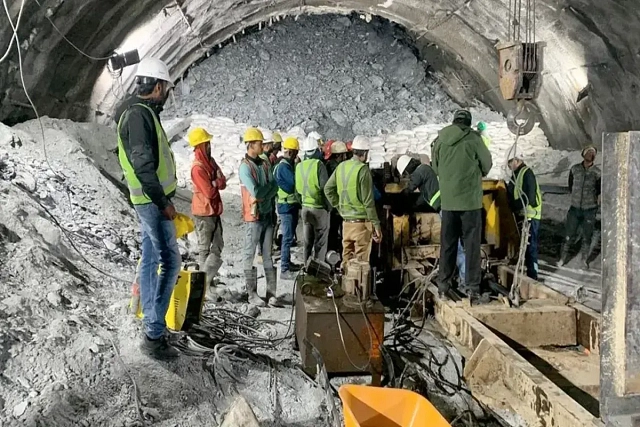News Brief
Day 6 Of Uttarkashi Tunnel Collapse Rescue Op Faces Minor Issue With Drilling Machine; Exit Plan Of Trapped Workers Explained
- The machine managed to drill 22 meters before encountering a minor issue.
- If the current machine stops functioning, a backup machine has been called from Indore to complete the job.

'American auger' machine has been introduced at the Silkyara Tunnel in Uttarkashi
After six days of the rescue operation in Uttarkashi to save 40 trapped construction workers in the Silkyara-Barkot tunnel, a high-capacity drilling machine was brought in from the national capital. By Friday (17 November) afternoon, it managed to drill 22 meters before encountering a minor issue.
The "horizontal dry drilling equipment with an auger" made in America had to cease operations because it began to lift off the ground when attempting to drill deeper. At the time of reporting, the rescuers were securing the machine to the platform to prevent this issue.
The machine came to a halt after four six-metre pipes had been inserted, with a fifth one currently being positioned. Once the drilling through the 50-plus metres of rubble is finished, the workers will exit through these pipes, Indian Express reported.
Anshu Manish Khalkho, the Director of National Highways and Infrastructure Development Corporation Limited, announced earlier today that they have requested a high-capacity drilling machine from Indore as a backup.
"We have made good progress, reaching a depth of approximately 24 meters. Our goal is to reach the other side as quickly as possible. To ensure the continuity of our work, we have arranged for another machine to be transported from Indore, which is expected to arrive by Saturday morning. If the current machine stops functioning, we can rely on the backup machine to complete the job," Khalkho explained in the afternoon.
When questioned about the speed of the operation, the drilling machine is currently progressing at a rate of approximately 1 metre per hour. The priority is to proceed with extreme caution and ensure that the pipes are perfectly aligned, avoiding any misalignment even by a centimetre.
Khalkho mentioned that according to their calculations, they anticipate a breakthrough after excavating for approximately 35 more metres. The pipes are six metres in length and are aligned on the machine.
"The auger drills the debris and pushes the muck backwards. This process does not take much time. However, the process of aligning the pipes and welding them is much more complicated. We do not want the pipes to be misaligned even by one centimetre. This is why the rate is slow, but with workers getting more experience, the rate will increase,” he explained adding that to ensure speed they have deployed four-five welders to work simultaneously.
Another crucial consideration is that the machine operates on diesel fuel and is located in a confined space. As a result, it is essential to have continuous ventilation using the compressor.
Due to the lack of alternatives, diesel machines are being used in a confined space, despite the ideal recommendation against it. The machines generate vibrations and require continuous ventilation, which may disrupt the existing equilibrium within the tunnel. Therefore, it is important to work at an optimal speed rather than rushing through the process.
The NDRF conducted a mock drill on Thursday night to evaluate their rescue strategy for the workers after the drilling is finished. Initially, the plan was to create a narrow and secure passage for the men to crawl through. However, they have now decided to use stretchers connected by ropes, equipped with wheels. Once the pipes are in place, the workers will climb onto the stretchers and be pulled to the other side using the ropes.
Support Swarajya's 50 Ground Reports Project & Sponsor A Story
Every general election Swarajya does a 50 ground reports project.
Aimed only at serious readers and those who appreciate the nuances of political undercurrents, the project provides a sense of India's electoral landscape. As you know, these reports are produced after considerable investment of travel, time and effort on the ground.
This time too we've kicked off the project in style and have covered over 30 constituencies already. If you're someone who appreciates such work and have enjoyed our coverage please consider sponsoring a ground report for just Rs 2999 to Rs 19,999 - it goes a long way in helping us produce more quality reportage.
You can also back this project by becoming a subscriber for as little as Rs 999 - so do click on this links and choose a plan that suits you and back us.
Click below to contribute.
Latest